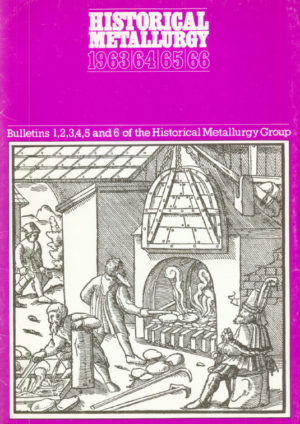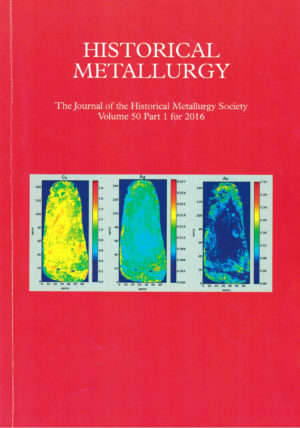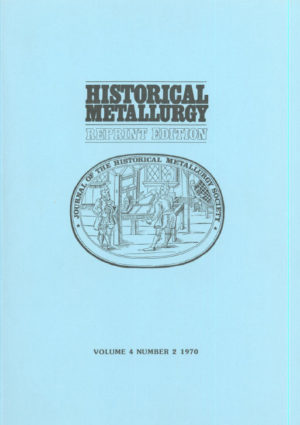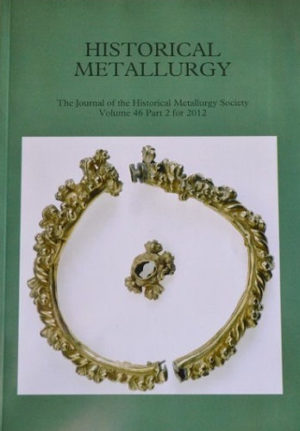Journal Contents
Professor Ronald Frank Tylecote 1916-1990
Pages 1-11
When Ronnie Tylecote died in June 1990, there ended a remarkable period of 28 years of development of this society, its journal and the subject of archaeometallurgy. In 1962, as Charles BUck relates below, Ronnie was one of a small group interested in the recording and preservation of the sites of charcoal blast furnaces, a concern prominent in early issues of what was then known as the Bulletin of the Historical Metallurgy Group. But his interests were far wider: in the same year he published Metallurgy in Archaeology, which was the first book to give a broad view of archaeometallurgy, a key text for archaeologists even after its author elaborated its themes in his later books. The Bulletin soon began to reflect this range of interest, and the wider archaeological community realised that in Ronnie there was a source of information and advice crucial to the interpretation of many sites, artefacts and residues which had previously been examined and published in a summary manner. In all this work he was ably supported by his wife Elizabeth whose linguistic and research assistance he always acknowledged. To her we owe a great debt for making it all possible. The memoirs which we publish below demonstrate how widely Ronnie’s influence was felt.
For the present editors, this has been a time not only to look back at our predecessor’s own writing, set out in the bibliography which we print in this issue, but to remind ourselves of his concept of the place of this journal in archaeological studies. His modesty precluded any explicit statement of his aims, but it is clear that these were to develop a key journal of record which was to be world-wide in its coverage. This has been expressed in editorial encouragement given to contributors from many countries, and in the importance attached to a comprehensive abstracting service. These are aims re-affirmed by the Council of the Society and by the editors.
Publications by R F Tylecote
Pages 12-20
The Experimental Production of Prehistoric Bar Iron
Peter Crew
Pages 21-36
Over a number of years iron working experiments have been carried out, based on the use of bog iron ores. The smelting has been done in a variety of low shaft furnaces, without slag tapping, and the products have been smithed to billet, bar and artefact. The smelting and, especially, the smithing processes are described in some detail, with discussion of some of the practical problems encountered.
In the most successful experiment yet carried out the whole bloom was smithed to make a currency bar. The yield of iron and the losses at various stages of the process are given, together with a quantificatin of the resources required. It is estimated that the production of one kilogram of fully smithed bar iron required about 100kg of charcoal and about 25 manday’s work.
A Tibetan text on metalworking from the collected writings of ' Ju Mi-Pham
Chandra L . Reedy
Pages 37-46
There was abundant production of metal sculptures, ornaments, ritual objects, and utensils in Tibet from the eleventh century until the recent Chinese occupation. However, Tibetan metalworking techniques have not been extensively studied. Comparative ethnographic studies have focused on artists in adjacent regions, particularly the Newars of Nepal. Technical studies of Tibetan objects are usually restricted to elemental analysis of the metals, and do not often include a study of casting, repairing, finishing, and decorating techniques. Few Tibetan texts discuss metalworking. One late-nineteenth century Tibetan text found within a volume on crafts is translated here. The main part of the text concerns soldering techniques and is followed by a discussion of recipes for producing artificial patinas.
Early blast furnace notes
Assembled by Charles Blick and the Early Blast-furnace Committee
Pages 47-
The last News appeared in JHMS 19/1, 1985. In the intervening five years much new work has been undertaken, and an update has been compiled. Authors’ names have been given where applicable. Peter King and Peter Hutchison are identified by their initials.
In 1987 Philip Riden produced A Gazetteer of Charcoal-fired Blast Furnaces in Great Britain in use since 1660 (ISBN 0950329967: from Dept of Extra-mural Studies, University College, Cardiff). This includes 170 sites, some not previously recorded, with bibliographical references, indication of surviving remains if any, and NGR. The Society’s index of blast furnaces contains, at present, 90 sites on which there are visible remains of both charcoal and coke-fired furnaces. 40 if these sites are common to both the Riden and Society lists.
![[Test] The Historical Metallurgy Society](https://test.historicalmetallurgy.org/wp-content/uploads/2020/02/Logo120.png)





There are no reviews yet.